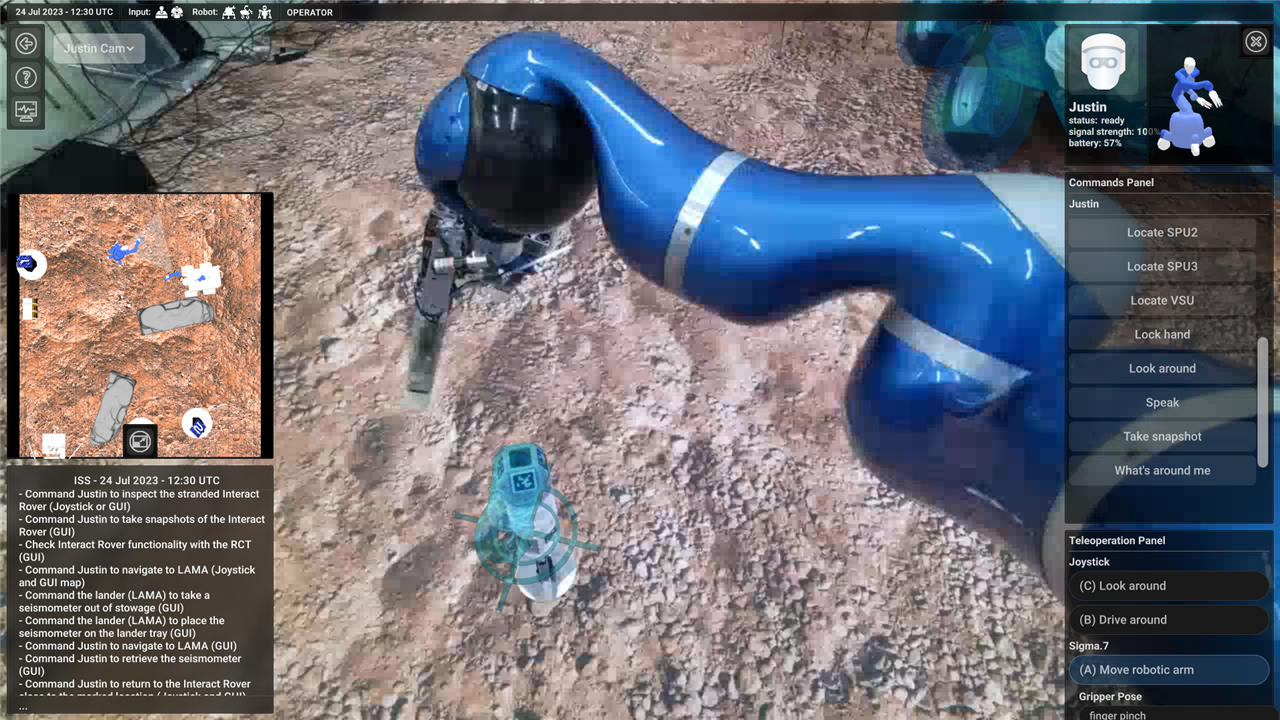
Frank Rubio controlled a team of robots from the International Space Station. (Image Credit: NASA/ESA)
To test out the idea of humans and robots working together on the moon, astronaut Frank Rubio, stationed on the ISS, controlled robots to perform a complex task. He ran this two-hour telerobotics test in DLR, a German Aerospace Center at Oberpfaffenhofen Munich. Rubio's job involved using a force feedback device to instruct three robotic assets to take a seismometer off a lunar lander, putting it on the ground for moonquake detections. In this role, a DLR robotic lander arm worked with DLR's Justin humanoid robot and ESA's four-wheeled, two-armed Interact rover.
By taking on this project, astronauts can get a clear picture of what they'll need while operating bots with scalable autonomy. As a result, the astronauts could have more leeway in terms of controlling the robots. During the first "Surface Avatar" series test, Justin had to take out a stuck pin in the lander before positioning the seismometer. A quake damaged the Interact rover while collecting surface samples. This also meant Justin needed to free the stuck sample in the gripper before putting it on the lander.

The Rollin' Justin robot places a canister during the Surface Avatar test. (Image Credit: DLR)
However, this didn't slow Rubio down whatsoever, and he offered insights on the UI and robots' features. These are expected to be added and validated in the next Surface Area session in January 2024. A bigger team of robots could be used in the next test, which is expected to be overseen by Andreas Mogensen, a Danish ESA astronaut, while he tackles his Huginn mission this year.
There's just too much distance involved in spaceflight for remotely controlling robots on the moon or other planets from Earth. That's why astronauts in orbit should control those robots, allowing them to explore and complete tasks on the moon. This idea can also be applied to other planets without landing.
"Our METERON project undertaken with DLR, proved the feasibility of this force-feedback control technique from local orbit, expanding to work with astronauts on the ISS and culminating in an outdoor campaign in the Moon-like environment of Mount Etna in Sicily," says Thomas Krueger, head of ESA's Human-Robot Interaction Lab, partnering with DLR's Institute of Robotics and Mechatronics. "With Surface Avatar, we combining direct teleoperation approach with supervised autonomy to control multiple robotic assets to accomplish complex tasks: picture a building site on Earth, where a crane might work alongside a bulldozer or excavator to get a big task done."

A robotic eye view of Rollin' Justin placing the seismometer on the ground. (Image Credit: ESA/DLR)
The Surface Avatar test simulates the surrounding environment of a planet's surface, and the robots know how to interact with some objects and other robots. The controller can then choose a list of options with an AR display. If an option is unavailable, the astronaut uses direct control instead, replicating what the robot arm feels via a force-feedback control device for higher precision.
"What we want to find out with this testing is how the astronauts perform in practice. What control mode do they choose? Do they have situational awareness by seeing the world through the eyes of multiple robots? And what judgments they make in their head about how to act?"
"We are excited to be a step closer to giving astronauts and experts on Earth a wide range of possibilities to command and manage teams of different robots in space," says Principal Investigator Neal Y. Lii from the DLR Institute of Robotics and Mechatronics. "We will be able to use our robots on the surface as their physical avatars and intelligent co-workers to execute ever more complex tasks."
Almost like it was pulled straight from the Uchū Kyōdai manga. Remote robotic control.
Have a story tip? Message me at: http://twitter.com/Cabe_Atwell
